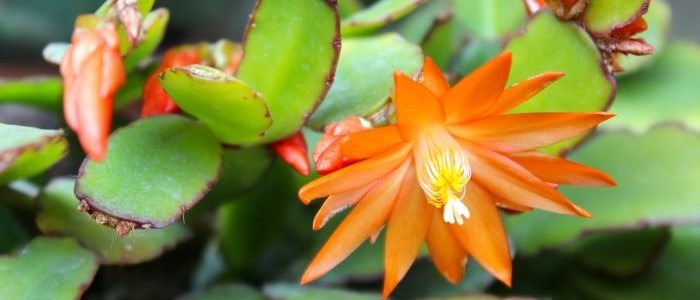The Easter Cactus (Rhipsalidopsis gaertneri) is a unique and beautiful species of cactus native to Brazil. It’s epiphytic nature means that it grows on other plants or objects instead of in the soil, making it an ideal choice for both indoor and outdoor spaces. This winter-blooming cactus blooms between March and April, with vibrant pink flowers that will bring a splash of colour to your home or garden.
The Easter Cactus has flattened stems with numerous notches along its edges, which distinguishes it from the Thanksgiving Cactus (Schlumbergera truncata), which has more pointed stems and blooms between October and November. The Easter Cactus’ delicate leaves are reddish-purple in color, while its flowers can range from light pink to deep magenta.
This species of cactus has evolved over thousands of years in response to the environment in which it lives – such as temperature, light levels, humidity, etc. Its adaptation allows it to survive even under difficult conditions – making it an excellent choice for gardens located in hot climates or with limited water resources. As well as being resilient and easy to care for, this cactus can also live for many years if given the right care and attention.
If you are looking for a unique addition to your home or garden then look no further than the Easter Cactus! With its vibrant colours and easy maintenance requirements this beautiful plant is sure to bring joy into your space!

The Easter Cactus Frequently Asked Questions
When does the Easter cactus to bloom?
The Easter cactus typically begins to bloom in spring, usually around the Easter holiday. This timing coincides with the arrival of warmer temperatures and longer daylight hours, which triggers the plant to produce vibrant blossoms. Unlike Christmas cacti, which bloom in late fall or early winter, the Easter cactus brings a burst of color and beauty to gardens and homes during the spring season.
Does the Easter cactus like sun or shade?
The Easter cactus prefers bright, indirect sunlight. While it can tolerate some direct sun, too much can cause its leaves to burn. Therefore, it is best to place the Easter cactus in a location where it can receive filtered light or partial shade throughout the day.
Planting and Growing an Easter Cactus
Planting and growing an Easter Cactus is a relatively easy process. It can be planted in either soil or a potting mix designed for cacti and succulents, as long as the soil is well-draining. The plant should be planted at the same depth it was in the container it came in. If you decide to grow your Easter Cactus outdoors, make sure it is placed in an area that gets morning sun but is sheltered from intense afternoon heat.
The temperature requirements for an Easter Cactus are quite specific – they prefer temperatures between 65-75°F during the day and 55-65°F at night. If you live in a colder climate, you may need to bring your Easter Cactus indoors during winter months to protect it from frost damage.
When it comes to watering your Easter Cactus, it’s important to keep the soil moist without overwatering. Allow the top layer of soil to dry out before watering again; this should occur every 7–10 days depending on humidity levels and other environmental factors such as wind or direct sunlight exposure. During its active growth period (between spring and summer), fertilize monthly with a balanced fertilizer specifically formulated for cacti and succulents, following package instructions carefully.
It’s important to repot your Easter Cactus every two years or so into fresh potting mix; this will help keep the plant healthy and encourage new growth. When repotting, use cacti or succulent soil with perlite or pumice added for extra drainage; make sure there are plenty of drainage holes at the bottom of the pot too!
Finally, watch out for pests like mealybugs and scale insects which can infest your Easter Cactus if left unchecked; inspect leaves regularly for signs of infestation and act quickly if found. By following these steps, you can successfully care for an Easter Cactus year after year!
Easter Cactus Light and Temperature Requirements
When caring for an Easter Cactus, proper light and temperature requirements are essential for its growth. It’s important to keep the cactus in a bright location with filtered sunlight. This means avoiding direct sunlight during the hottest times of the day, as this can cause leaf burn or dry out the soil too quickly. The ideal temperature range for an Easter Cactus is 65-75 degrees Fahrenheit (18-24 degrees Celsius).
Humidity plays an important role in keeping your cactus healthy. Maintain a humidity level between 40-50%, as higher levels can encourage mold and mildew growth. Additionally, make sure to protect your cactus from temperatures below 60 degrees Fahrenheit (15 degrees Celsius). If temperatures drop too low, it can experience shock and may not recover well.
During winter months, you should keep your Easter Cactus in a cool room with temperatures no lower than 50 degrees F (10 degrees C). Keeping it in cooler climates helps promote flowering and reduce any stress on the plant due to too much heat or intense light exposure. It’s best to keep the plant away from cold drafts if possible as well.
Overall, providing proper light and temperature requirements is key when caring for an Easter Cactus. Make sure to provide bright filtered light while avoiding direct sunlight during peak hours and maintain optimal temperatures of 65-75°F (18-24°C). Keep humidity levels between 40-50% and remember not to let temperatures dip below 60°F (15°C) or expose your cactus to cold drafts during winter months. With careful attention and regular care, you can enjoy this beautiful species of cacti blooming year after year!
Watering and Fertilizing an Easter Cactus
Watering and Fertilizing an Easter Cactus The key to getting the most out of your Easter Cactus is ensuring that you provide it with the correct amount of water and nutrients. If not watered properly, this cactus can suffer from dehydration or root rot, so it’s important to keep an eye on its soil moisture levels.
When watering your Easter Cactus, aim for infrequent but deep watering sessions. Wait until the topsoil feels dry or slightly damp before watering again, as overwatering can cause root rot in these plants. It is also important to ensure good drainage – use a pot with holes at the bottom and avoid standing water at all costs.
Fertilizing is another essential aspect of caring for your Easter Cactus. During the summer months, when it is actively growing, fertilize once a month with a liquid fertilizer (follow instructions on bottle for dilution). Avoid fertilizing during winter months when the plant is dormant– this could damage or kill it.
Overall, providing your Easter Cactus with sufficient sunlight and well-draining soil will help ensure that it remains healthy and blooms year after year. With proper care, you’ll be able to enjoy this beautiful cactus for many years to come!
Propagating an Easter Cactus
Propagating an Easter cactus is a simple process that can be done in late spring or early summer. All you need to do is take a 4-inch cutting from a healthy stem with two nodes, let it dry for a few days, and then plant it in a cactus mix soil. To ensure your cutting doesn’t rot away, make sure you use sterilized scissors or shears when snipping off the cutting.
Once the cutting has been planted, make sure to keep the soil moist and place the cutting in a warm, bright spot with indirect sunlight. It is also important to monitor your new plants for any signs of pests or disease and take appropriate action if necessary.
With the right care, you can have an Easter cactus that will last for many years and bring a splash of color to your home or garden. The trick is to provide an optimal environment for your Easter Cactus – one that mimics its natural growing conditions as closely as possible. This includes providing plenty of fresh air circulation and regular waterings without over-saturating the soil. Once established, they are relatively low maintenance plants and require minimal attention – making them ideal houseplants!
Easter Cactus Common Pests and Diseases
The Easter Cactus is a beautiful cactus species that can bloom with vibrant pink flowers between March and April. However, like any other plant, it is prone to common pests and diseases. Knowing how to identify these issues and treat them is essential for keeping your Easter Cactus in top condition.
Spider mites are one of the most commonly encountered pests when growing an Easter Cactus. They are tiny arachnids usually found on the underside of leaves or stems and can cause leaf discoloration, yellowing or dropping off of leaves, and webbing on the plant. To get rid of spider mites, use a soft cloth to wipe the leaves and stems with soapy water or insecticidal soap every two weeks until they are gone.
Mealybugs are also common pests on Easter Cacti. These small white insects feed on sap from the plant’s stems and leaves, causing discoloration of foliage as well as sticky residue on the surface of the plant. To remove mealybugs, spray them with rubbing alcohol directly from a bottle or use insecticidal soap every two weeks until they’re gone.
Scale insects look like small bumps on your Easter Cactus’s stems or leaves but can cause serious damage if left untreated. To get rid of scale insects, spray them with rubbing alcohol directly from a bottle or use insecticidal soap every two weeks until they’re gone.
Root rot is caused by overwatering your Easter Cactus which results in soggy soil that can lead to fungal diseases such as powdery mildew and gray mold. It also causes root decay which weakens the overall health of your cactus over time. To prevent root rot keep an eye out for soggy soil by checking it regularly and reduce watering frequency accordingly if needed.
Fungus gnats lay eggs in wet soil around plants roots which then hatch into larvae that feed on organic matter in soil leading to stunted growth or even death if left untreated for too long. To get rid off fungus gnats introduce beneficial nematodes into your soil which eat up larvae before they have a chance to mature into adults thus eliminating this pest problem organically without using chemicals.
Finally foliar nematodes are microscopic worms that feed on plant tissue resulting in yellowing of foliage followed by wilting and eventual death if left untreated for too long. To prevent foliar nematodes you should avoid over-fertilizing your plants, check new plants prior to purchasing them, practice good hygiene, rotate crops annually, ensure adequate drainage, water only when necessary, etc.
With proper care and attention, you can avoid all these common pests and diseases that affect the Easter Cactus while enjoying its vibrant pink blooms year after year!
Conclusion
Final Thoughts Caring for an Easter Cactus is a rewarding experience that can bring joy and vibrant blooms year after year. To ensure your cactus thrives, it is important to provide the right environment and follow the necessary steps for successful planting and growing.
Firstly, place your Easter Cactus in a bright location with filtered sunlight and maintain a temperature range of 65-75°F (18-24°C). Humidity levels should be kept between 40-50%, and temperatures should not drop below 60°F (15°C). During winter months, the cactus should be kept in a cool room with temperatures no lower than 50°F (10°C).
Secondly, water the cactus infrequently but deeply, ensuring good drainage. Fertilize once a month with a liquid fertilizer during summer months but avoid fertilizing during winter months.
Thirdly, if pests or diseases appear, practice good hygiene as well as rotation of crops annually. Additionally, check new plants before purchasing them and reduce overwatering and fertilizing. Finally, introduce beneficial nematodes into the soil to help prevent any issues from arising in the future. It is also important to repot your Easter Cactus every two years so that it can continue to thrive in its environment.
Lastly, propagate an Easter Cactus by taking 4-inch cuttings with two nodes from healthy stems. Dry these cuttings for several days before planting them in cactus mix soil and providing an optimal environment including fresh air circulation and regular waterings without over-saturating the soil. With careful attention and regular care, this beautiful cactus can last for many years while bringing you much joy!
Other House Plants With Orange Flowers













